Haryana State Board HBSE 10th Class Maths Solutions Chapter 4 Quadratic Equations Ex 4.3 Textbook Exercise Questions and Answers.
Haryana Board 10th Class Maths Solutions Chapter 4 Quadratic Equations Ex 4.3
Question 1.
Find the roots of the following quadratic equations, if they exist, by the method of completing the squsire :
(i) 2x2 – 7x + 3 = 0
(ii) 2x2 + x – 4 = 0
(iii) 4x2 + 4√3x + 3 = 0
(iv) 2x2 + x + 4 = 0
Solution :
(i) The given equation is :
2x2 – 7x + 3 = 0
⇒ x2 – \(\frac{7}{2}\)x + \(\frac{3}{2}\) = 0
[Dividing throughout by 2]
⇒ x2 – \(\frac{7}{2}\)x = – \(\frac{3}{2}\)
⇒ x2 \(\frac{7}{2}\)x + (\(\frac{7}{4}\))2 = – \(\frac{3}{2}\) + (\(\frac{7}{4}\))2
[Adding (\(\frac{1}{2}\) coeff. of x)2 of both sides]
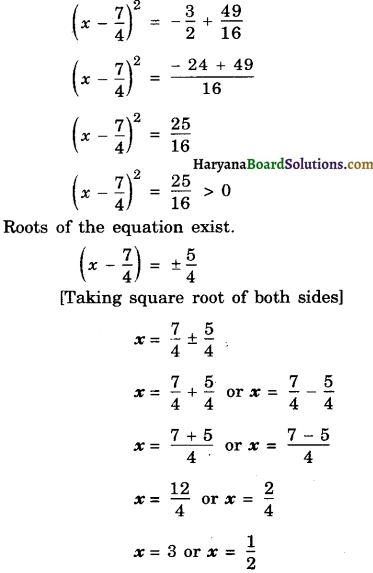
![]()
(ii) The given equation is:
2x2 + x – 4 = 0
x2 + \(\frac{x}{2}\) – 2 = 0
[Dividing throughout by 2]
x2 + \(\frac{x}{2}\) = 2

Hence, the roots of the equation are \(\frac{-1+\sqrt{33}}{4}\) and \(\frac{-1-\sqrt{33}}{4}\).
(iii) The given equation is :
4x2 + 4√3x + 3 = 0
⇒ x2 + √3x + \(\frac{3}{4}\) = 0
[Dividing throughout by 4]
x2 + √3x = – \(\frac{3}{4}\)
[Adding (\(\frac{1}{2}\) coeff. of x)2 of both side]
(x + \(\frac{\sqrt{3}}{2}\))2 = \(-\frac{3}{4}+\frac{3}{4}\)
(x + \(\frac{\sqrt{3}}{2}\))2 = 0
∴ The roots of the equation exist.
∴ (x + \(\frac{\sqrt{3}}{2}\))2 = 0
x = – \(\frac{\sqrt{3}}{2}\), – \(\frac{\sqrt{3}}{2}\)
Hence, the roots of the equation are – \(\frac{\sqrt{3}}{2}\) and – \(\frac{\sqrt{3}}{2}\).
![]()
(iv) The given equation is :
2x2 + x + 4 = 0
⇒ x2 + \(\frac{x}{2}\) + 2 = 0
[Dividing throughout by 2]
x2 + \(\frac{x}{2}\) = – 2
\(x^2+\frac{x}{2}+\left(\frac{1}{4}\right)^2=-2+\left(\frac{1}{4}\right)^2\)
[Adding (\(\frac{1}{2}\) coeff. of x)2 of both sides]
\(\left(x+\frac{1}{4}\right)^2=-2+\frac{1}{16}\)
\(\left(x+\frac{1}{4}\right)^2=\frac{-32+1}{16}\)
\(\left(x+\frac{1}{4}\right)^2=\frac{-31}{16}\) < 0
∴ The roots of the equation do not exist.
![]()
Question 2.
Find the roots of the quadratic equations given in question 1 above by applying the quadratic formula.
Solution :
(i) The given equation is :
2x2 – 7x + 3 = 0
Here, a = 2, b = – 7, c = 3
∴ D = b2 – 4ac
⇒ D = (- 7)2 – 4 × 2 × 3
⇒ D = 49 – 24
⇒ D= 25
D > 0
∴ The equation has real roots.
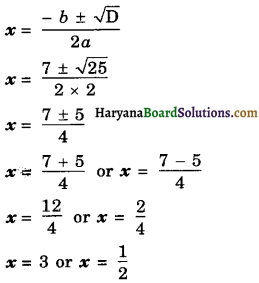
(ii) The given equation is 2x2 + x – 4 = 0
Here, a = 2, b = 1, c = – 4
∴ D = b2 – 4ac
⇒ D = (1)2 – 4 × 2 × (- 4)
⇒ D = 1 + 32
⇒ D = 33
∵ D > 0
∴ The equation has real roots.
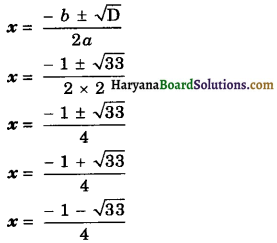
Hence, the roots of the equation are \(\frac{-1+\sqrt{33}}{4}\) and \(\frac{-1-\sqrt{33}}{4}\).
![]()
(iii) The given equation is :
4x2 + 4√3 + 3 = 0
Here, a = 4, b = 4√3 , c = 3
∴ D = b2 – 4ac
⇒ D = (4√3)2 – 4 × 4 × 3
⇒ D = 48 – 48
∵ D = 0
∴ The equation has real roots.
∴ x = \(\frac{-b \pm \sqrt{\mathrm{D}}}{2 a}\)
x = \(\frac{-4 \sqrt{3} \pm 0}{2 \times 4}\)
x = \(-\frac{\sqrt{3}}{2}\)
Hence, the roots of the equation are \(-\frac{\sqrt{3}}{2}\) and \(-\frac{\sqrt{3}}{2}\).
(iv) The given equation is :
2x2 + x + 4 = 0
Here, a = 2, b = 1, c = 4
D = b2 – 4ac
⇒ D= (1)2 – 4 × 2 × 4
⇒ D = 1 – 32
⇒ D = – 31
∵ D < 0
∴ Roots of the equation do not exist.
Hence, the equation has no real roots.
![]()
Question 3.
Find the roots of the following equations:
(i) x – \(\frac{1}{x}\) = 3, x ≠ 0
(ii) \(\frac{1}{x+4}-\frac{1}{x-7}=\frac{11}{30}\), x ≠ – 4, 7
Solution:
(i) The given equation is
x – \(\frac{1}{x}\) = 3
Multiplying both sides by x, we get
⇒ x2 – 1 = 3x
⇒ x2 – 3x – 1 = 0
Here, a = 1, b = – 3, c = – 1
∴ D = b2 – 4ac
D = (- 3)2 – 4 × 1 × (- 1)
D = 9 + 4
D = 13
∵ D > 0
∴ The equation has real roots.
x = \(\frac{-b \pm \sqrt{D}}{2 a}\)
x = \(\frac{3 \pm \sqrt{13}}{2 \times 1}\)
x = \(\frac{3+\sqrt{13}}{2}\) or x = \(\frac{3-\sqrt{13}}{2}\)
Hence, the roots of the equation are \(\frac{3+\sqrt{13}}{2}\) and \(\frac{3-\sqrt{13}}{2}\).
(ii) The given equation is:
\(\frac{1}{x+4}-\frac{1}{x-7}=\frac{11}{30}\)
\(\frac{x-7-x-4}{(x+4)(x-7)}=\frac{11}{30}\)
\(\frac{-11}{x^2-3 x-28}=\frac{11}{30}\)
11x2 – 33x – 308 = – 330
11x2 – 33x – 308 + 330 = 0
11x2 – 33x + 220 = 0
x2 – 3x + 2 = 0
Here, a = 1, b = – 3, c = 2
∴ D = b2 – 4ac
D = (- 3)2 – 4 × 1 × 2
D = 9 – 8
D = 1
∵ D > 0
∴ The equation has real roots.
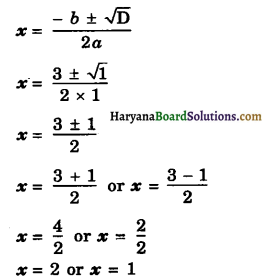
x = 2 or x = 1
Hence, the roots of the equation are 2 and 1.
![]()
Question 4.
The sum of the reciprocals of Rehman’s ages (in years) 3 years ago and 5 years from now is Find his present age.
Solution :
Let the present age of Rehman be x years
3 years ago Rehmans age = (x – 3) years
After 5 years Rehxnan’s age = (x + 5) years
According to question,
\(\frac{1}{x-3}+\frac{1}{x+5}=\frac{1}{3}\)
\(\frac{x+5+x-3}{(x-3)(x+5)}=\frac{1}{3}\)
\(\frac{2 x+2}{x^2+2 x-15}=\frac{1}{3}\)
= x2 + 2x – 15 = 6x + 6
x2 + 2x – 15 – 6x – 6 = 0
x2 – 4x – 21 = 0
Here, a = 1, b = – 4, c = – 21.
∴ D = b2 – 4ac
D = (- 4)2 – 4 × 1 × (- 21)
D = 16 + 84
D = 100
∵ D > 0
Then, roots of the equation are given by
∴ x = \(\frac{-b \pm \sqrt{D}}{2 a}\)
x = \(\frac{4 \pm \sqrt{100}}{2 \times 1}\)
x = \(\frac{4 \pm \{10}}{2 }\)
⇒ x = 2 ± 5
⇒ x = 2 + 5 or x = 2 – 5
⇒ x = 7 or x = – 3.
Since, x is the present age ofRehman. It cannot be negative.
Therefore, x = 7.
Hence, the present age of Rehman = 7 years.
![]()
Question 5.
In a class test, the sum of Shefali’s marks in Mathematics and English is 30. Had she got 2 marks more in Mathematics and 3 marks less in English, the product of their marks would have been 210. Find her marks in the two subject?.
Solution:
Let the marks obtained by Shefali in Mathematics be x
Then, marks obtained by Shefali in English = 30 – x .
According to question,
(x + 2)(30 – x – 3) = 210
⇒ (x + 2) (27 – x)= 210
⇒ 27x – x2 + 54x – 2x = 210
⇒ – x2 + 25x + 54 – 210 = 0
⇒ – x2 + 25x – 156 = 0
⇒ x2 – 25x + 156 = 0
Here, a = 1, 6 = – 25, c = 156
∴ D =b2 – 4ac
⇒ D = (- 25)2 – 4 x 1 x 156
⇒ D= 625 – 624
⇒ D = 1
∵ D > 0
Then roots of the equation are given by
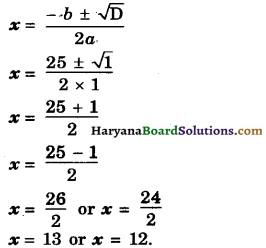
Hence, Marks in Mathematics = 12, Marks in English = 30 – 12 = 18.
Or Marks in Mathematics = 13,
Marks in English 30 – 13 = 17.
![]()
Question 6.
The diagonal of a rectangular field is 60 m more than the shorter side. If the longer side is 30 m more than the shorter side. Find the sides of the field.
Solution :
Let the shorter side of the rectangular field be x m.
Then diagonal = (x + 60) m
and longer side = (x + 30) m
In a right triangle ABC.
By Pythagoras theorem, we get
(x + 60)2 = (x + 30)2 + x2
x2 + 120x + 3600 = x2 + 60x + 900 + x2
x2 + 120x + 3600 – 2x2 – 60x – 900 = 0
– x2 + 60x+ 2700 = 0
x2 – 60x – 2700 = 0

Here, a = 1, b = – 60, c = – 2700
⇒ D = b2 – 4oc
⇒ D = (- 60)2 – 4 × 1 × (- 2700)
⇒ D = 3600 + 10800
⇒ D = 14400
Then, the roots of the equation are given by

Since, x is the shorter side of a rectangular field. It cannot be negative.
Therefore, x = 90
Hence, the sides of the rectangular field are 90 m and (90 + 30)m = 120 m.
![]()
Question 7.
The difference of squares of two numbers is 180. The square of the smaller number is 8 times the larger number. Find the two numbers.
Solution :
Let the larger number be x and smaller number be y.
Then, according to question,
x2 – y2 = 180 ……………….(1)
and y2 = 8x …………………(2)
Substituting the value of y2 in equation (1), we get
x2 – 8x = 180
⇒ x2 – 8x – 180 = 0
Here, a = 1, b = – 8, c = – 180
D = b2 – 4ac
⇒ D = (- 8)2 – 4 × 1 × (- 180)
⇒ D = 64 + 720
⇒ D = 784
∵ D > 0
Then, the roots of the equation are given by
x = \(\frac{-b \pm \sqrt{D}}{2 a}\)
x = \(\frac{8 \pm \sqrt{784}}{2 \times 1}\)
x = \(\frac{8 \pm 28}{2}\)
⇒ x = – 4 ± 14
⇒ x = 4 + 14 or x = 4 – 14
⇒ x = 18 or x = – 10
Substituting the values of x in equation (2), we get
If x = 18,
y2 = 8 x 18
⇒ y2 = 144
⇒ y = ± 12
If x = – 10,
y2 = 8 x -10
⇒ y2 = – 80
⇒ y = √-80
We cannot find the value of √-80 .
Hence, the two numbers are 18, 12 or 18, – 12.
![]()
Question 8.
A train travels 360 km at a uniform speed. If the speed had been 5 km/h more, it would have taken 1 hour less for same journey. Find the speed of the train.
Solution :
Let the speed of train be x km/h.
Time taken by the train = \(\frac{360}{x}\) hours
[Time = \(\frac{\text { Distance }}{\text { Speed }}\)]
If the speed of the train is 5 km/h more
Then new speed of the train = (x + 5) km/h
and time taken by the train = \(\frac{360}{x+5}\) hours
According to question,
\(\frac{360}{x}-\frac{360}{x+5}\) = 1
⇒ \(\frac{360(x+5)-360 x}{x(x+5)}\) = 1
⇒ \(\frac{360 x+1800-360 x}{x^2+5 x}\) = 1
⇒ \(\frac{1800}{x^2+5 x}\) = 1
⇒ x2 + 5x = 1800
⇒ x2 + 5x – 1800 = 0
Here, a = 1, b = 5, c = – 1800
∴ D = b2 – 4ac
⇒ D = (5)2 – 4 × 1 × (- 1800)
⇒ D = 25 + 7200
⇒ D = 7225
∵ D > 0
Then, the roots of the equation are given by

Since x is the speed of a train. It cannot be negative.
Therefore, x = 40.
Hence, the speed of train = 40 km/h.
![]()
Question 9.
Two water taps together can fill a tank in 9\(\frac{3}{8}\) hours. The tap of larger diameter takes 10 hours less than the smaller one to fill the tank separately. Find the time in which each tap can separately fill the tank.
Solution :
Let time taken by smaller tap be x hours
and time taken by larger tap be (x -10) hours.
Time taken by both taps together be 9\(\frac{3}{8}\) hours
The portion of tank filled by smaller tap in 1 hour = \(\frac{1}{x}\)
The portion of tank filled by larger tap in 1 hour = \(\frac{1}{x-10}\)
The portion of tank filled by both taps together in 1 hour = \(\frac{1}{9 \frac{3}{8}}\)
According to question,
\(\frac{1}{x}+\frac{1}{x-10}=\frac{1}{9 \frac{3}{8}}\)
\(\frac{x-10+x}{x(x-10)}=\frac{1}{\frac{75}{8}}\)
\(\frac{2 x-10}{x^2-10 x}=\frac{8}{75}\)
⇒ 8x2 – 80x = 150x – 750
⇒ 8x2 – 80x – 150x + 750 = 0
⇒ 8x2 – 230x + 750 = 0
Here, a = 8, b = – 230, c = 750
∴ D = b2 – 4ac
⇒ D = (- 230)2 – 4 × 8 × 750
⇒ D = 52900 – 24000
D = 28900
D > 0
Then, the roots of the equation are given by
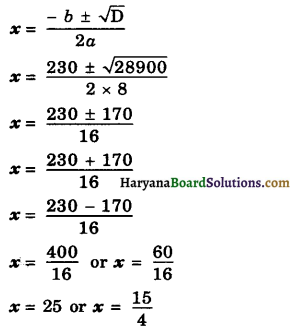
We reject x = \(\frac{15}{4}\)
Therefore, x = 25
Hence, the smaller tap takes time = 25 hours
And the larger tap takes time = 25 – 10 = 15 hours.
![]()
Question 10.
An express train takes 1 hour less than a passenger train to travel 132 km between Mysore and Bangalore (Without taking into consideration the time they stop at intermediate stations). If the average speed of the express train is 11 km)h more than that of the passenger train. Find the average speed of the two trains.
Solution:
Let the average speed of passenger train be x km/h.
Then the average speed of express train = (x + 11) km/h
Time taken by passenger train to cover 132 = 132 hours
[∵ Time = Distance/ Speed]
Time taken by express train to cover 132 km = \(\frac{132}{x+11}\) hours
According to question,
\(\frac{132}{x}-\frac{132}{x+11}\) = 1
\(\frac{132(x+11)-132 x}{x(x+11)}\) = 1
\(\frac{132 x+1452-132 x}{x^2+11 x}\) = 1
\(\frac{1452}{x^2+11 x}\) = 1
x<sup>2</sup> + 11x = 1452
x<sup>2</sup>+ 11x – 1452 = 0
Here, a = 1, b = 11, c = – 1452
∴ D = b<sup>2</sup> – 4ac
D = (11)<sup>2</sup> – 4 × 1 × (- 1452)
D = 121 + 5808
D = 5929
D > 0
Then, the roots of the equation are given by

Since, x is the average speed of the passenger train. It cannot be negative.
Therefore, x = 33
Hence, the average speed of passenger train = 33 km/h
and average speed of express train = 33 + 11 = 44km/h.
![]()
Question 11.
The sum of the areas of two squares is 468 m2. If the difference of their perimeters is 24 m. Find the sides of the two squares.
Solution :
Let the side of larger square be x m and side of smaller square be y m.
According to question,
x2 + y2 = 468 ……………..(1)
and 4x – 4y = 24
x – y = 6
⇒ x = 6 + y ………………..(2)
Substituting the value of x in equation (1), we get
(6 + y)2 + y2 = 468
⇒ 36 + 12y + y2 + y2 = 468
⇒ 2y2 + 12y + 36 – 468 = 0
⇒ 2y2 + 12y – 432 = 0
⇒ y2 + 6y – 216 = 0
Here, a = 1, b = 6, c = – 216
D = b2 – 4ac
D = (6)2 – 4 × 1 × (- 216)
D = 36 + 864
D = 900
D > 0
Then, the roots of the equation are given by

Since, y is the side of smaller square. It cannot be negative.
Therefore, y = 12
Substituting the value of y in equation (2), we get
x = 6 + 12
⇒ x = 18
Hence, the sides of the two squares are 18 m and 12 m.